英语语法倒装讲解
语法:英语倒装

语法:英语倒装1.概念:有时由于语法或修辞的需要将谓语的部分或全部提到主语前面,这样的语序叫做倒装:①语法结构的需要通常体现在疑问句、there be 结构等需要用倒装句;②语法修饰的需要:倒装句可以起强调作用,加强语气。
2.分类:英语最基本的词序是主语在谓语动词的前面。
如果将句子的主语和谓语完全颠倒过来,这称之为完全倒装。
如果只将助动词或情态动词移至主语之前,谓语的其他部分仍保留在主语的后面,这称之为部分倒装。
3.用法:Ⅰ.完全倒装是将谓语的全部放在主语之前,此结构通常只用于一般现在时和一般过去时两种,例如:On her left sat her husband. 她左边坐着她丈夫。
Here is the book you want. 你要的书在这儿。
Down went the small boat. 小船沉下去了。
Ⅰ.部分倒装是指将谓语的一部分,如助动词或情态动词,移至主语之前。
Only by working hard can one succeed. 只有努力才能成功。
Never have I seen her before. 我以前没见过她。
注意:如果句中的谓语没有助动词或情态动词,则需添加助动词do, does或did,并将其置于主语之前。
4.常见倒装句式:Ⅰ. There be句型;A book is there on the desk.→There is a book on the desk.An old man lives there by the sea.→There lives an old man by the sea.Ⅰ. here、there、now、then等开头的句子;Here comes the bus! / Now comes your turn.但是注意,如果主语是人称代词,则不倒装,如:Here you are. / There she comes.Ⅰ. 当表示地点的介词词组在句首;At the foot of the hill lies a beautiful lake.Under the tree was lying a cat.Ⅰ. 句首为否定或半否定的词语;如no, not, never, seldom, little, hardly, at no time, in no way, not until…等。
倒装句语法讲解
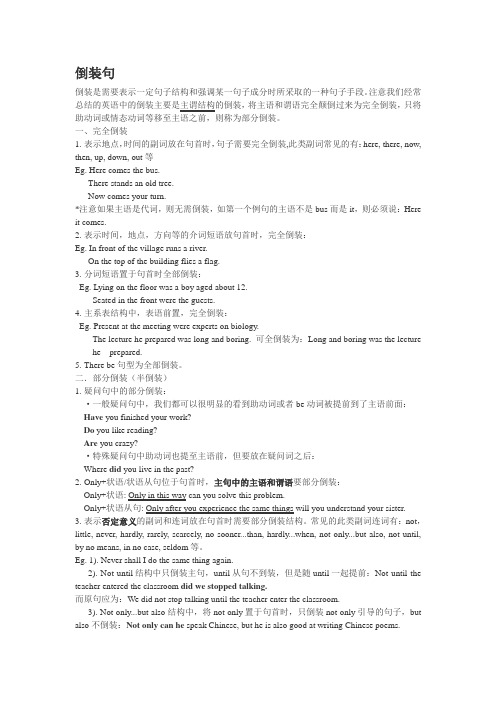
倒装句倒装是需要表示一定句子结构和强调某一句子成分时所采取的一种句子手段。
注意我们经常总结的英语中的倒装主要是主谓结构的倒装,将主语和谓语完全颠倒过来为完全倒装,只将助动词或情态动词等移至主语之前,则称为部分倒装。
一、完全倒装1.表示地点,时间的副词放在句首时,句子需要完全倒装,此类副词常见的有:here, there, now, then, up, down, out等Eg. Here comes the bus.There stands an old tree.Now comes your turn.*注意如果主语是代词,则无需倒装,如第一个例句的主语不是bus而是it,则必须说:Here it comes.2.表示时间,地点,方向等的介词短语放句首时,完全倒装:Eg. In front of the village runs a river.On the top of the building flies a flag.3.分词短语置于句首时全部倒装:Eg. Lying on the floor was a boy aged about 12.Seated in the front were the guests.4.主系表结构中,表语前置,完全倒装:Eg. Present at the meeting were experts on biology.The lecture he prepared was long and boring. 可全倒装为:Long and boring was the lecture he prepared.5.There be句型为全部倒装。
二.部分倒装(半倒装)1.疑问句中的部分倒装:·一般疑问句中,我们都可以很明显的看到助动词或者be动词被提前到了主语前面:Have you finished your work?Do you like reading?-Are you crazy?·特殊疑问句中助动词也提至主语前,但要放在疑问词之后:Where did you live in the past?2.Only+状语/状语从句位于句首时,主句中的主语和谓语要部分倒装:Only+状语: Only in this way can you solve this problem.Only+状语从句: Only after you experience the same things will you understand your sister.3.表示否定意义的副词和连词放在句首时需要部分倒装结构。
高中英语语法倒装句讲解

高中英语语法倒装句讲解倒装句倒装句是英语中常见的一种句式,它的特点是把谓语动词放在主语之前,以达到强调的效果。
在倒装句中,常用的有全部倒装和部分倒装两种形式。
一、全部倒装全部倒装即把整个谓语部分放在主语之前。
当副词here。
there。
in。
out。
up。
down。
away。
back。
then。
ahead,off。
over等位于句首、谓语动词常为be。
come。
go。
follow。
run。
rush。
fly。
fall等不及物动词,而且主语又是名词时,用完全倒装。
注意:此类倒装只限于一般现在时和一般过去式,不用进行时态并且若主语是代词时,不用倒装。
同学们可借助下面的图形速记用于完全倒装的词。
1.介词短语(地点状语)+不及物动词+主语A beautiful girl sits under the tree。
= Under the tree sits a beautiful girl。
树下坐着一位漂亮的女孩。
A big ___ of the lake。
= South of the ___的南边是一个大超市。
A modern swimming pool is located 20 miles east of our school。
= 20 miles east of our school ___。
我们学校向东20英里有一个现代化的游泳池。
Piles of old books。
magazines and newspapers are on the floor。
= On the floor were piles of old books。
magazines and newspapers。
地板上是一堆堆旧的书报杂志。
2.表方向、地点的副词(here。
there。
up。
down。
away)+不及物动词+主语,构成的全部倒装句___ ___ barking fiercely。
away fled the ___。
听到狗的狂叫声,小偷逃掉了。
英语倒装句的用法归纳
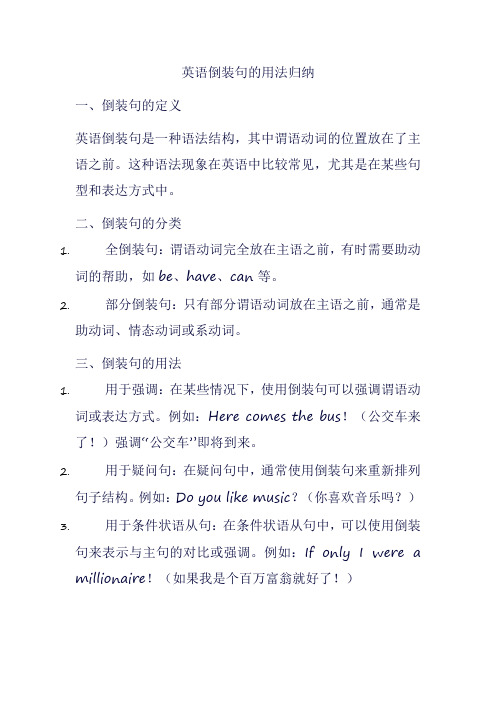
英语倒装句的用法归纳一、倒装句的定义英语倒装句是一种语法结构,其中谓语动词的位置放在了主语之前。
这种语法现象在英语中比较常见,尤其是在某些句型和表达方式中。
二、倒装句的分类1.全倒装句:谓语动词完全放在主语之前,有时需要助动词的帮助,如be、have、can等。
2.部分倒装句:只有部分谓语动词放在主语之前,通常是助动词、情态动词或系动词。
三、倒装句的用法1.用于强调:在某些情况下,使用倒装句可以强调谓语动词或表达方式。
例如:Here comes the bus!(公交车来了!)强调“公交车”即将到来。
2.用于疑问句:在疑问句中,通常使用倒装句来重新排列句子结构。
例如:Do you like music?(你喜欢音乐吗?)3.用于条件状语从句:在条件状语从句中,可以使用倒装句来表示与主句的对比或强调。
例如:If only I were a millionaire!(如果我是个百万富翁就好了!)4.用于让步状语从句:在让步状语从句中,可以使用倒装句来表示转折关系。
例如:Try to find a way to solve the problem!(试着找到解决问题的方法!)5.用于虚拟语气:在虚拟语气中,可以使用倒装句来表示与实际情况相反的情况。
例如:If I were you,I would go to the party.(如果我是你,我会去参加派对。
)6.用于某些固定句型:有些固定句型要求使用倒装句。
例如:“Hardly had she sat down when the phone rang.”(她刚坐下电话就响了。
)7.表示惊讶、感叹、讽刺等情绪时也可以使用倒装句。
例如:How could you do such a thing!(你怎么能做出这种事!)四、倒装句的用法归纳总结1.英语倒装句是一种语法结构,主要有全倒装句和部分倒装句两种类型。
2.使用倒装句可以强调谓语动词或表达方式,也可以用于疑问句、条件状语从句、让步状语从句和虚拟语气等语法结构中。
英语语法——倒装
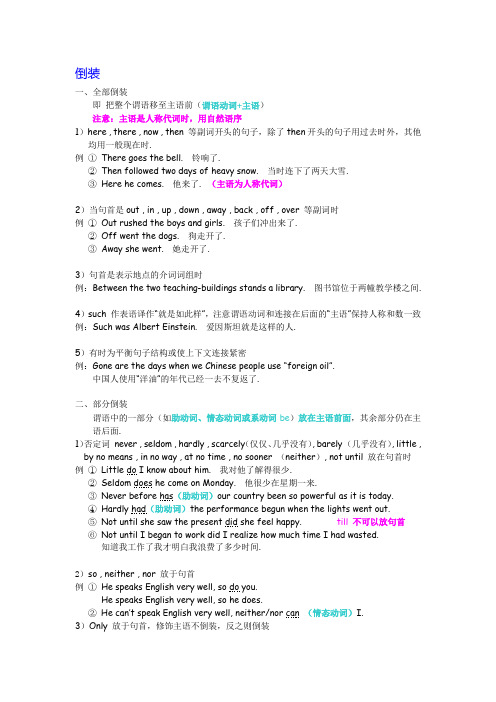
倒装一、全部倒装即把整个谓语移至主语前(谓语动词+主语)注意:主语是人称代词时,用自然语序1)here , there , now , then 等副词开头的句子,除了then开头的句子用过去时外,其他均用一般现在时.例①There goes the bell. 铃响了.②Then followed two days of heavy snow. 当时连下了两天大雪.③Here he comes.他来了. (主语为人称代词)2)当句首是out , in , up , down , away , back , off , over 等副词时例①Out rushed the boys and girls. 孩子们冲出来了.②Off went the dogs. 狗走开了.③Away she went. 她走开了.3)句首是表示地点的介词词组时例:Between the two teaching-buildings stands a library. 图书馆位于两幢教学楼之间.4)such 作表语译作“就是如此样”,注意谓语动词和连接在后面的“主语”保持人称和数一致例:Such was Albert Einstein. 爱因斯坦就是这样的人.5)有时为平衡句子结构或使上下文连接紧密例:Gone are the days when we Chinese people use “foreign oil”.中国人使用“洋油”的年代已经一去不复返了.二、部分倒装谓语中的一部分(如助动词、情态动词或系动词be)放在主语前面,其余部分仍在主语后面.1)否定词never , seldom , hardly , scarcely(仅仅、几乎没有), barely (几乎没有), little , by no means , in no way , at no time , no sooner (neither), not until 放在句首时例①Little do I know about him. 我对他了解得很少.②Seldom does he come on Monday. 他很少在星期一来.③Never before has(助动词)our country been so powerful as it is today.④Hardly had(助动词)the performance begun when the lights went out.⑤Not until she saw the present did she feel happy. till 不可以放句首⑥Not until I began to work did I realize how much time I had wasted.知道我工作了我才明白我浪费了多少时间.2)so , neither , nor 放于句首例①He speaks English very well, so do you.He speaks English very well, so he does.②He can‟t speak English very well, neither/nor can (情态动词)I.3)Only 放于句首,修饰主语不倒装,反之则倒装例①Only Tom knows the secret. (主语为Tom , only修饰Tom)②Only after she left the cinema , did she find that she had lost her handbag. 4)as 表示虽然的意思5)not only…but also , so…that , such…that 等句型中,主语倒装,从句不倒装例①Not only is she clever, but also she is kind.②Not only does John love Chinese, but he is good at speaking it.③Not only had the poor man been arrested, but(also)he had been sent to prisonas well.④So fast does light travel that it‟s difficult for us to imagine its speed.⑤So angry was Mary that she couldn‟t speak.6)happy , especially , with good reson 放在句首同样要倒装,以加强语气.例①Happy did they live tonight.②Especial in spring do I like the country. 我尤其喜欢春天的乡下.·关于nothing , none , no one 在情景对话中的几种句型:1.——“What …s on the blackboard?”——“Nothing.”(以“what”提问通常用“nothing”回答)2.——“Who is in the office?”——“Nobody(no one).”(用“who”提问的常用此)3.——“Did any of my students call me just now?”——“None.”(问句中有范围如“any of my students”, 用none 回答)4.——“Did any one call me just now?”——“No one.”(问句中的“any one”没有范围,所以用“no one”)5.——“Is there any water in the bottle?”——“None.”(“any water”指具体事物,也可表示有范围)6.——“Is there anything in the bottle?”——“Nothing.”(“anything”没有明确指出具体范围或事物,所以用“nothing”)。
高三英语语法讲解----倒装句

主句
从句
I did not know the truth until I saw the pistachio nuts.
Not until I saw the pistachio nuts did I know the truth.
until从句不倒装
not主句半倒装(一般疑问பைடு நூலகம்构)
Page 17
二、部分倒装
Page 15
二、部分倒装
部分倒装:将谓语动词的一部分(助动词/系动词/情态动词)置于主语前 情况1:当否定词或者带有否定意义的词或短语位于句首时 【学以致用】
I seldom arrange homework to students. Seldom do I arrange homework to students
他冲出去了
Out he rushed.
注意: 如果主语为人称代词,则不需要倒装。
Page 10
一、全部倒装
全部倒装:全部谓语放在主语之前 情况2:地点方位介词置于句首时 如on the wall, under the tree, in front of the house, in the middle of the room等
部分倒装:将谓语动词的一部分(助动词/系动词/情态动词)置于主语前 情况1:当否定词或者带有否定意义的词或短语位于句首时 特殊用法2:not only…but also【前倒后不倒】 My brother not only cheated me out of my money but also insulted my intelligence. Not only did my brother cheat me out of my money but also insulted my intelligence. 但not only...but also...连接主语时,不倒装。 Not only the mother but also the children are sick. 特殊用法3:“一……就……”句型的倒装 Hardly/Scarcely/Barely had + 主语 + done when + 主 + 谓 Hardly had he sworn to god when it thundered. No sooner had + 主语 + done than 主 + 谓 No sooner had he sworn to god than it thundered.
英语语法-倒装(高中英语必备)
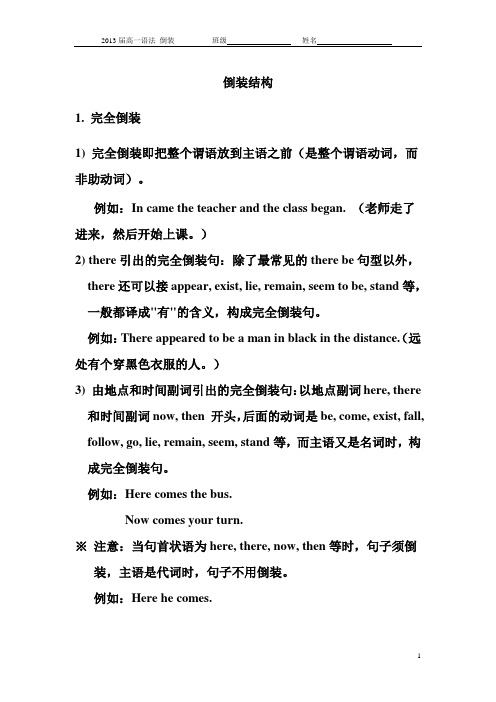
倒装结构1. 完全倒装1) 完全倒装即把整个谓语放到主语之前(是整个谓语动词,而非助动词)。
例如:In came the teacher and the class began. (老师走了进来,然后开始上课。
)2) there引出的完全倒装句:除了最常见的there be句型以外,there还可以接appear, exist, lie, remain, seem to be, stand等,一般都译成"有"的含义,构成完全倒装句。
例如:There appeared to be a man in black in the distance.(远处有个穿黑色衣服的人。
)3) 由地点和时间副词引出的完全倒装句:以地点副词here, there 和时间副词now, then 开头,后面的动词是be, come, exist, fall, follow, go, lie, remain, seem, stand等,而主语又是名词时,构成完全倒装句。
例如:Here comes the bus.Now comes your turn.※注意:当句首状语为here, there, now, then等时,句子须倒装,主语是代词时,句子不用倒装。
例如:Here he comes.4)表示运动方向的副词或地点状语置于句首,谓语表示运动的动词且主语是名词时使用完全倒装例如:Up went the plane.. the plane went up.In came the chairman.注意:如果主语是代词则不发生倒装。
例如:Out they rushed!Lower and lower he bent.5) 在直接引语之后在叙事性书面语中,直接引语后常跟asked Mary, answered John, said the old lady, grunted Peter之类的词语。
在这些词语中,动词常的主语之前。
高中英语语法——倒装句

倒装句倒装的原因:①语法原因②强调③平衡句子结构④承上启下完全倒装:整个谓语都在主语之前。
部分倒装:助动词/be/情态动词等放在主语之前。
一、完全倒装:整个谓语都在主语之前1. there be句型(特殊的全部倒装句型):其中be可换为appear, come,exist, happen,lie,live,stand等动词。
[exist/iɡ'zɪst/ vi.存在;生存]There is an experienced teacher and many lovely students in the classroom. 教室里有一位经验丰富的老师和许多可爱的学生。
There stands a temple on the top ofthe mountain. 山顶上有座庙。
2. 将here, there, now, then等地点或时间副词置于句首,且谓语动词是be, come, go, remain, lie, run等,且主语为名词时,用完全倒装。
—Is everyone here? 每个人都在这儿吗?—Not yet ... Look, there come the rest of our guests! 还没有。
看,其余的客人来了。
Here comes my list of dos and don’ts:... 下面是我的行为准则:...Here is some advice for you to follow while listening to his lecture.下面是你听他的报告时可以遵循的一些建议。
3. 表示运动方向的副词out, in, up, down, away等置于句首,谓语是表示运动的动词,且主语为名词时,句子要用完全倒装。
In the dark corner of the room, up jumped the cat and caught the mouse. 在房间黑暗的角落里,那只猫跳了上去并抓住了那只老鼠。
关于倒装句的英语语法解析
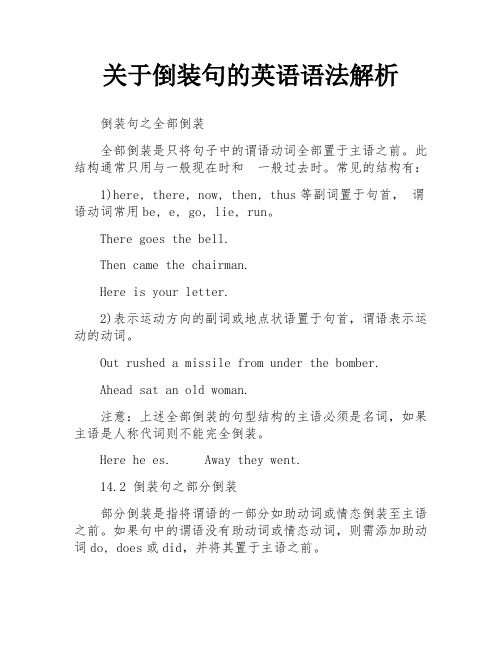
关于倒装句的英语语法解析倒装句之全部倒装全部倒装是只将句子中的谓语动词全部置于主语之前。
此结构通常只用与一般现在时和一般过去时。
常见的结构有:1)here, there, now, then, thus等副词置于句首,谓语动词常用be, e, go, lie, run。
There goes the bell.Then came the chairman.Here is your letter.2)表示运动方向的副词或地点状语置于句首,谓语表示运动的动词。
Out rushed a missile from under the bomber.Ahead sat an old woman.注意:上述全部倒装的句型结构的主语必须是名词,如果主语是人称代词则不能完全倒装。
Here he es. Away they went.14.2 倒装句之部分倒装部分倒装是指将谓语的一部分如助动词或情态倒装至主语之前。
如果句中的谓语没有助动词或情态动词,则需添加助动词do, does或did,并将其置于主语之前。
1)句首为否定或半否定的词语,如no, not, never, seldom, little, hardly, at no time, in no way, not until… 等。
Never have I seen such a performance.Nowhere will you find the answer to this question.Not until the child fell asleep did the mother leave the room.当Not until引出主从复合句,主句倒装,从句不倒装。
注意:如否定词不在句首不倒装。
I have never seen such a performance.The mother didn't leave the room until the child fell asleep.典型例题1)Why can't I smoke here?At no time___ in the meeting-roomA. is smoking permittedB.smoking is permittedC. smoking is it permittedD.does smoking permit答案A. 这是一个倒装问题。
英语倒装句的详细讲解
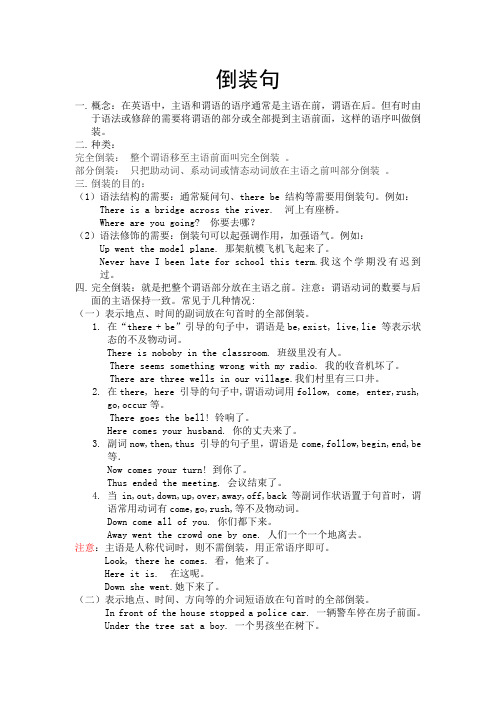
倒装句一. 概念:在英语中,主语和谓语的语序通常是主语在前,谓语在后。
但有时由于语法或修辞的需要将谓语的部分或全部提到主语前面,这样的语序叫做倒装。
二. 种类:完全倒装:整个谓语移至主语前面叫完全倒装。
部分倒装:只把助动词、系动词或情态动词放在主语之前叫部分倒装。
三. 倒装的目的:(1)语法结构的需要:通常疑问句、there be 结构等需要用倒装句。
例如:There is a bridge across the river. 河上有座桥。
Where are you going? 你要去哪?(2)语法修饰的需要:倒装句可以起强调作用,加强语气。
例如:Up went the model plane. 那架航模飞机飞起来了。
Never have I been late for school this term. 我这个学期没有迟到过。
四. 完全倒装:就是把整个谓语部分放在主语之前。
注意:谓语动词的数要与后面的主语保持一致。
常见于几种情况:(一)表示地点、时间的副词放在句首时的全部倒装。
1.在“there + be”引导的句子中,谓语是be,exist, live,lie 等表示状态的不及物动词。
There is noboby in the classroom. 班级里没有人。
There seems something wrong with my radio. 我的收音机坏了。
There are three wells in our village.我们村里有三口井。
2.在there, here 引导的句子中,谓语动词用follow, come, enter,rush,go,occur等。
There goes the bell! 铃响了。
Here comes your husband. 你的丈夫来了。
3.副词now,then,thus 引导的句子里,谓语是come,follow,begin,end,be等.Now comes your turn! 到你了。
高中英语语法倒装句总结讲解

高中英语语法倒装句总结讲解1. 完全倒装:即将谓语动词的全部置于主语之前。
常见用法:1) 当here, there, in, ou t, up, down, on 等副词置于句首,且主语为名词时;2) 将表示地点、方位的介词短语置于句首;3) 直接引语置于句首,其后的主语是名词时。
2. 部分倒装:即将谓语动词的一部分置于主语之前(如助动词be, do, have, will,和情态动词may, can, must, should 等)。
常见用法:1) 否定词或词组,如neither, nor, never, nowhere, not, seldom, rarely, scarcely, barely, hardly, no sooner, at no time, in no case, in no way, by no means, on no condition 等置于句首时;2) so 表示“也”,neither/ nor表示“也不”;so / such… that 表示“那样……以至于”置于句首时;3) only + 状语/ 状从,置于句首时, 主句要部分倒装;注意:当only + 主语置于句首时,则用正常语序。
4) not only … but also…引导两个分句时,not only 引导的分句要部分倒装;5) not until + 状语/ 状从,“直到……才”,置于句首时,主句要部分倒装;6) adj. / adv. / n. / v. / 分词+ as / though + 主语+ 谓语:引导让步状从,置于句首时;7) 在虚拟语气的条件句中,如含should, had, were, 可将它们置于句首,且省略if;8) 用于:May + 主语+ v. 结构中,表示“祝愿”;9) 表示次数、频率的副词置于句首时(也可用正常语序)。
倒装句口诀:副词开头要例装,人称代词则如常。
only修饰副介状,位于句首半倒装。
英语语法-倒装

第十三章倒装英语的基本语序是“主语+谓语”,如果将谓语的一部分或全部放在主语之前,这种语序叫倒装。
倒装既是一种语法手段,也是一种修辞手段,用于表示一定的句子结构或强调某一句子成分。
一.倒装的原因A.语法倒装由于语法结构的需要,将谓语的全部或一部分移到主语之前。
1.一般疑问句当我们把一个肯定句转变为疑问句时,常把肯定句中的助动词或情态动词放在句首。
这类助动词或情态动词包括:be,have,can,do,shall,will,may,must,dare,need,ought 或used 等。
He will do it.——Will he do it 他会做这件事吗?This is my mobile phone number.——Is this your mobile phone number?这是你的手机号码吗?提示:如果肯定句中没有助动词或情态动词时,我们可以在句首用do 的某种形式,以构成倒装语序。
Jack likes to eat fish. 杰克喜欢吃鱼。
——Does Jack like to eat fish 杰克喜欢吃鱼吗?2.特殊疑问句特殊疑问句的构成:特殊疑问词+ 一般疑问句What does he like to eat 他喜欢吃什么?When will they go to the Great Wall 他们什么时候去长城?Where did you go last night 昨晚你去哪里了?提示:如果疑问代词在句中做主语,句子不要倒装。
Who is not coming to dinner tonight 今晚谁不来吃饭?3. 反意问句在反意问句中,用一般疑问句的形式,前后两分句的主语,人称要一致。
前一分句是肯定,反意问句用否定形式,并一定要缩写;前一分句是否定, 反意问句用肯定形式。
Everything is ready, isn't it 一切都准备好了,是吗?Bobbie seldom got drunk, did he 博比很少喝醉,是吗?You had a wonderful time last night, didn't you 昨天晚上你玩得很愉快,是吗?4.感叹句英语中的感叹句有时也通过倒装的形式来表达。
语法中的倒装句用法详解

语法中的倒装句用法详解倒装句是英语语法中常见的一种句型,它在句子结构和语序上与一般句子相比有所不同。
倒装句的用法多样,包括完全倒装句、部分倒装句和条件状语从句中的倒装句等。
本文将详细解释倒装句的用法及其相关规则,并引用示例句子加以说明。
一、完全倒装句完全倒装句是指将助动词或情态动词放在句首,主语紧随其后,动词短语(或谓语)置于主语之后。
完全倒装句的常见情况有以下几种:1. 当表示地点或方向的副词置于句首时:例句:Up the hill ran the little boy.(小男孩跑上了山坡。
)例句:Here comes the bus.(车来了。
)例句:Out rushed the crowd when the door opened.(门一开,人群冲了出去。
)2. 当表示时间的副词或短语置于句首时:例句:Yesterday was I absent from school.(昨天我没去上学。
)例句:In a few minutes will the ceremony begin.(几分钟后,典礼将开始。
)例句:At the age of ten did he start learning the piano.(十岁时他开始学钢琴。
)3. 当以“here”或“there”开头时:例句:Here comes the bride.(新娘来啦。
)例句:There goes the alarm.(警报响了。
)例句:There hides a treasure in the cave.(洞里藏着一处宝藏。
)二、部分倒装句部分倒装句是指将助动词、情态动词或谓语动词的某些形式放在句首,主语置于动词之后,另一部分谓语成分仍位于句尾。
部分倒装句的常见情况如下:1. 在问句中:例句:Do you speak English?(你会讲英语吗?)例句:Have you finished your homework?(你完成作业了吗?)例句:Can he swim?(他会游泳吗?)2. 在以“never”、“seldom”、“rarely”、“not until”等否定副词或短语开头的句子中:例句:Never have I seen such a beautiful sunset.(我从未见过如此美丽的日落。
英语语法讲义--倒装
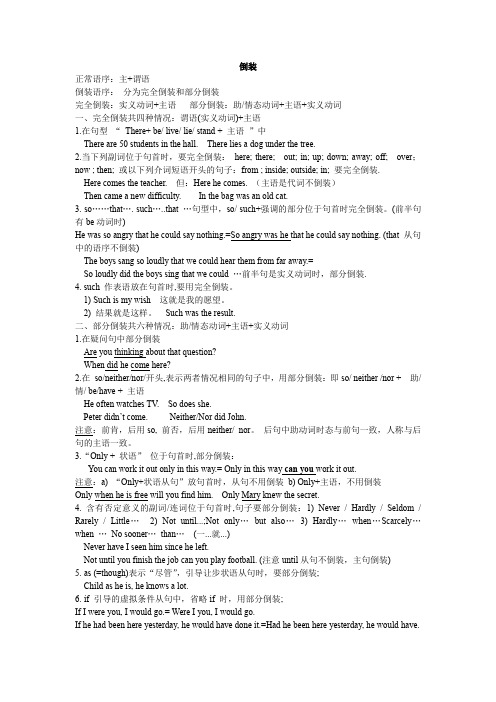
倒装正常语序:主+谓语倒装语序:分为完全倒装和部分倒装完全倒装:实义动词+主语部分倒装:助/情态动词+主语+实义动词一、完全倒装共四种情况:谓语(实义动词)+主语1.在句型“There+ be/ live/ lie/ stand + 主语”中There are 50 students in the hall. There lies a dog under the tree.2.当下列副词位于句首时,要完全倒装:here; there; out; in; up; down; away; off; over;now ; then; 或以下列介词短语开头的句子:from ; inside; outside; in; 要完全倒装.Here comes the teacher. 但:Here he comes. (主语是代词不倒装)Then came a new difficulty. In the bag was an old cat.3. so……that…. such…..that …句型中,so/ such+强调的部分位于句首时完全倒装。
(前半句有be动词时)He was so angry that he could say nothing.=So angry was he that he could say nothing. (that 从句中的语序不倒装)The boys sang so loudly that we could hear them from far away.=So loudly did the boys sing that we could …前半句是实义动词时,部分倒装.4. such 作表语放在句首时,要用完全倒装。
1) Such is my wish 这就是我的愿望。
2) 结果就是这样。
Such was the result.二、部分倒装共六种情况:助/情态动词+主语+实义动词1.在疑问句中部分倒装Are you thinking about that question?When did he come here?2.在so/neither/nor/开头,表示两者情况相同的句子中,用部分倒装:即so/ neither /nor + 助/情/ be/have + 主语He often watches TV. So does she.Peter didn’t come. Neither/Nor did John.注意:前肯,后用so, 前否,后用neither/ nor。
英语语法之倒装结构
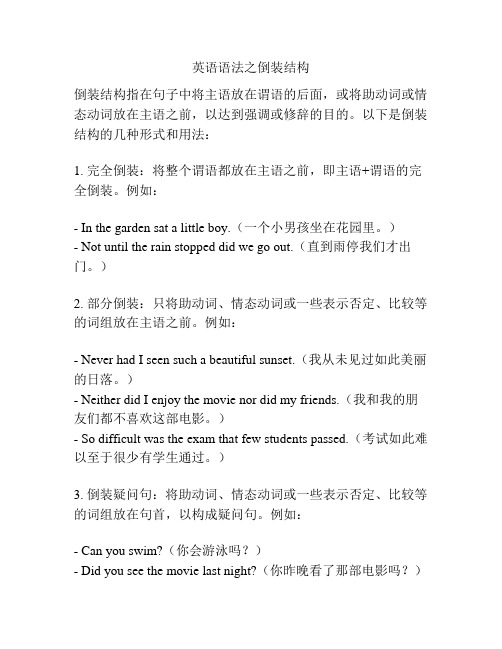
英语语法之倒装结构
倒装结构指在句子中将主语放在谓语的后面,或将助动词或情态动词放在主语之前,以达到强调或修辞的目的。
以下是倒装结构的几种形式和用法:
1. 完全倒装:将整个谓语都放在主语之前,即主语+谓语的完全倒装。
例如:
- In the garden sat a little boy.(一个小男孩坐在花园里。
)
- Not until the rain stopped did we go out.(直到雨停我们才出门。
)
2. 部分倒装:只将助动词、情态动词或一些表示否定、比较等的词组放在主语之前。
例如:
- Never had I seen such a beautiful sunset.(我从未见过如此美丽的日落。
)
- Neither did I enjoy the movie nor did my friends.(我和我的朋友们都不喜欢这部电影。
)
- So difficult was the exam that few students passed.(考试如此难以至于很少有学生通过。
)
3. 倒装疑问句:将助动词、情态动词或一些表示否定、比较等的词组放在句首,以构成疑问句。
例如:
- Can you swim?(你会游泳吗?)
- Did you see the movie last night?(你昨晚看了那部电影吗?)
- Have you ever been to England?(你去过英国吗?)
倒装结构的应用范围比较广泛,在正式场合、文学作品、口语交流等不同语境中都可以使用。
它通常用于强调、修辞或转换语气。
英语倒装句语法总结
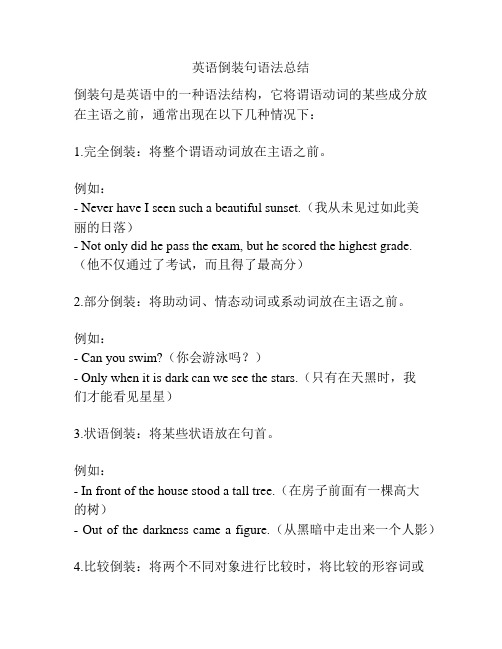
英语倒装句语法总结
倒装句是英语中的一种语法结构,它将谓语动词的某些成分放在主语之前,通常出现在以下几种情况下:
1.完全倒装:将整个谓语动词放在主语之前。
例如:
- Never have I seen such a beautiful sunset.(我从未见过如此美
丽的日落)
- Not only did he pass the exam, but he scored the highest grade.
(他不仅通过了考试,而且得了最高分)
2.部分倒装:将助动词、情态动词或系动词放在主语之前。
例如:
- Can you swim?(你会游泳吗?)
- Only when it is dark can we see the stars.(只有在天黑时,我
们才能看见星星)
3.状语倒装:将某些状语放在句首。
例如:
- In front of the house stood a tall tree.(在房子前面有一棵高大
的树)
- Out of the darkness came a figure.(从黑暗中走出来一个人影)
4.比较倒装:将两个不同对象进行比较时,将比较的形容词或
副词放在主语之前。
例如:
- Faster and faster ran the cheetah.(猎豹跑得越来越快)
需要注意的是,倒装句在一般陈述句中较少使用,在问句、条件句、感叹句等句型中更常见。
此外,倒装句的语序较正常语序更为强调或突出某种意义,所以在表达中需根据具体情况选择是否使用倒装句结构。
英语语法结构倒装句

英语语法结构--倒装句倒装句是英语语法中的一种结构,指的是将句子中的主语和谓语的位置颠倒,即将谓语置于主语之前。
倒装句在英语中使用频率较高,常用于强调、表示条件、表示地点和时间等情况下。
以下是关于倒装句的详细介绍。
一、完全倒装句完全倒装句是指将整个谓语放在主语之前,常见的结构有:1."助动词/情态动词 + 主语 + 谓语" 例如:•Can you swim? (你会游泳吗?)•Will she come tomorrow? (她明天会来吗?)•Should we start now? (我们现在应该开始吗?)•Had I known the truth, I wouldn't have gone. (如果我知道真相,我就不会走了。
)2."状语 + 动词 + 主语" 例如:•In came the teacher. (老师走了进来。
)•Out rushed the students. (学生们冲了出去。
)•Up went the balloon. (气球飘了上去。
)•Down fell the rain. (雨下了下来。
)3."there be" 结构的倒装例如:•There is a book on the desk. (桌子上有一本书。
)•There are many people in the park. (公园里有很多人。
)•There was a loud noise outside. (外面传来一声巨响。
)•There will be a meeting next week. (下周将有一次会议。
)二、部分倒装句部分倒装句是指将谓语中的助动词或情态动词放在主语之前,常见的结构有:1."助动词/情态动词 + 主语 + 不完全动词" 例如:•Did you see the movie? (你看过那部电影吗?)•Does she like ice cream? (她喜欢冰淇淋吗?)•Can I borrow your pen? (我可以借你的笔吗?)•Should we go now? (我们现在应该走吗?)2."情态动词 + 主语 + 动词" 例如:•Can you swim? (你会游泳吗?)•Will she come tomorrow? (她明天会来吗?)•Must he finish the report today? (他必须今天完成报告吗?)•Should we start now? (我们现在应该开始吗?)3."副词 + 助动词/情态动词 + 主语 + 动词" 例如:•Never have I seen such a beautiful sunset. (我从未见过如此美丽的日落。
英语语法之倒装
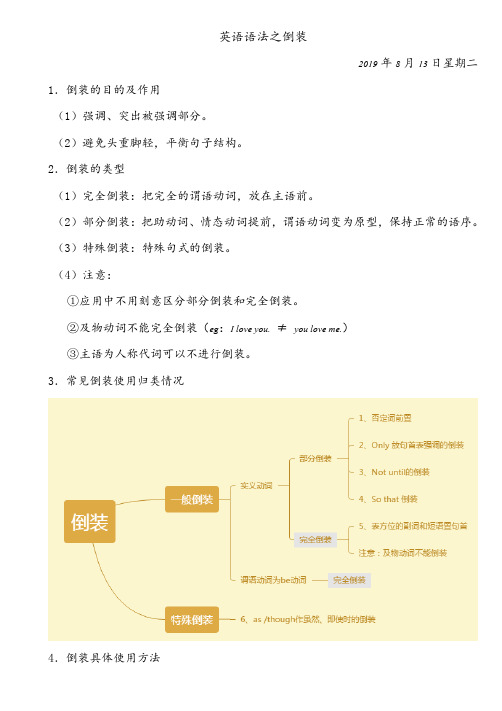
英语语法之倒装2019年8月13日星期二1.倒装的目的及作用(1)强调、突出被强调部分。
(2)避免头重脚轻,平衡句子结构。
2.倒装的类型(1)完全倒装:把完全的谓语动词,放在主语前。
(2)部分倒装:把助动词、情态动词提前,谓语动词变为原型,保持正常的语序。
(3)特殊倒装:特殊句式的倒装。
(4)注意:①应用中不用刻意区分部分倒装和完全倒装。
②及物动词不能完全倒装(eg:I love you. ≠you love me.)③主语为人称代词可以不进行倒装。
3.常见倒装使用归类情况4.倒装具体使用方法(1)否定词前置,进行部分倒装①否定词1)单词:never , rarely , scarcely , not , seldom , little , hardly 等2)词组:in no way , on no account , not a bit ,not often , under no circumstances等②主谓倒装1)谓语动词为实义动词a.把隐藏的助动词do / dose / did 放在主语前面,动词位置不变。
2)谓语动词含有have / has /had 和情态动词a.把have / has /had 和情态动词提到主语前,动词位置不变。
3)Be动词a.直接把be动词提到主语前,相当于全部倒装。
③例句:1)Rarely does he go to school. ←(He rarely goes to school)2)Seldom have I seen such interesting book. ←(I have seldom seen such interesting book.)3)Rarely will you hear such beautiful and exciting music. ←(You will Rarely hear such beautiful and exciting music.)4)Nowhere was the lost pet dog to be found . ←(The lost pet dog was to be found nowhere .) (2)Only 放句首表强调的倒装①Only+被强调部分(状语)1)Only+副词only then2)Only+介词短语after引导的短语,in this way等等3)Only+从句if引导的从句,when引导的从句等等②倒装部分1)谓语动词是be动词a.Only+被强调部分提到首句,将be动词提到主语前。
(完整版)高中英语语法倒装句讲解及练习(附答案)
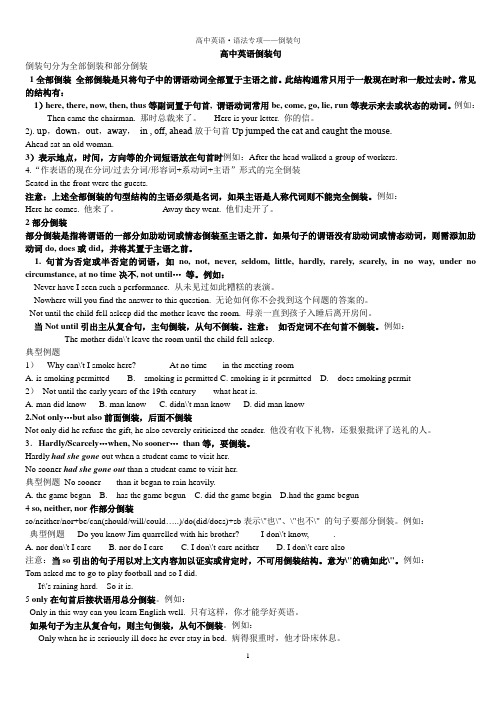
高中英语倒装句倒装句分为全部倒装和部分倒装1全部倒装全部倒装是只将句子中的谓语动词全部置于主语之前。
此结构通常只用于一般现在时和一般过去时。
常见的结构有:1)here, there, now, then, thus等副词置于句首, 谓语动词常用be, come, go, lie, run等表示来去或状态的动词。
例如:Then came the chairman. 那时总裁来了。
Here is your letter. 你的信。
2). up,down,out,away,in , off, ahead放于句首Up jumped the cat and caught the mouse.Ahead sat an old woman.3)表示地点,时间,方向等的介词短语放在句首时例如:After the head walked a group of workers.4.“作表语的现在分词/过去分词/形容词+系动词+主语”形式的完全倒装Seated in the front were the guests.注意:上述全部倒装的句型结构的主语必须是名词,如果主语是人称代词则不能完全倒装。
例如:Here he comes. 他来了。
Away they went. 他们走开了。
2部分倒装部分倒装是指将谓语的一部分如助动词或情态倒装至主语之前。
如果句子的谓语没有助动词或情态动词,则需添加助动词do, does或did,并将其置于主语之前。
1. 句首为否定或半否定的词语,如no, not, never, seldom, little, hardly, rarely, scarely, in no way, under no circumstance, at no time决不, not until…等。
例如:Never have I seen such a performance. 从未见过如此糟糕的表演。
Nowhere will you find the answer to this question. 无论如何你不会找到这个问题的答案的。
- 1、下载文档前请自行甄别文档内容的完整性,平台不提供额外的编辑、内容补充、找答案等附加服务。
- 2、"仅部分预览"的文档,不可在线预览部分如存在完整性等问题,可反馈申请退款(可完整预览的文档不适用该条件!)。
- 3、如文档侵犯您的权益,请联系客服反馈,我们会尽快为您处理(人工客服工作时间:9:00-18:30)。
零代沟Grammar: Inversion英语中主语在前谓语在后的语序称为自然语序。
由于语法、修辞的需要谓语置于主语之前,称为全部倒装助动词、情态动词等移到主语之前而主要动词仍然在主语之后的,称作部分倒装。
(1)为了叙述或描绘更加生动,将表示运动方向的副词(如“here, there, out, in, up, off, down,away, back等)放到句首。
注意:这种句子必须是谓语动词为go, come, run, rush等表示位移的动词,主语是名词。
Here comes the bus.There goes the bell.Down came the rainOut rushed a tiger from the wood.(2)当句首是表示地点的介词短语时,为了保持句子结构的平衡或是为了使上下文更加紧密衔接时,常使用倒装。
In the center of the hall stands a white piano.Among them was a soldier who was wounded in the shoulder. (3)用so表示“我也这样”一类概念时,常用以下结构:肯定:so + be/ have/ 助动词/ 情态动词+ 主语否定:nor/ neither + be/ have/ 助动词/ 情态动词+ 主语He has visited the museum. ―So have I.She can swim. -So can I.The boy can’t skate. -Nor can his brother. (Neither can his brother.)(4)副词only所强调的方式状语、条件状语、地点状语、时间状语等位于句首时,采用部分倒装。
Only by taking a taxi can you arrive there on time.Only in this way can you make progress in English.Only when she came home did he learn the news.(5)为了强调句子中的否定状语,常将其置于句首,通常采用部分倒装。
这类常见的具有否定意义的副词、连词和短语有:副词:few, little, never, not, nowhere, rarely, seldom连词:not until, not only...but also, no sooner…than, hardly…when短语:at no time, by no means, on no account, in no circumstances 绝不Not until all the fish died in the river, did the villagers realize how serious the pollution was.Not a single song did sh e sing at yesterday’s party.No sooner had he arrived than he fell ill.(6)虚拟语气的非真实条件句中若含有“were, had, should等词”,可以省略连词if,并把were等移到句首,构成倒装。
Were he here now, he would tell us what to do.Had I the time, I would go.Should it not rain, the crops would die.(7)让步状语从句可以采用如下结构。
形容词/名词+ as + 主语+ 谓语Clever as he i s, he doesn’t study well.Child as he was, he lived on himself.(8)so...that so在句首修饰形容词或副词表示强调时,主句要用倒装语序,后面以that引导的结果状语从句采用自然语序。
So shallow is the lake that no fish can live in it.So loudly did he speak that people upstairs could hear him. (9)however为连接副词,引导让步状语从句,其意义和作用相当于no matter how。
可用于如下结构:however + 形容词/副词+ 主语+ 谓语However late he is, Mother will wait for him to have dinner together.We’ll have to finish the jog, however long it takes.Practice(1) Not until he failed in the exam ___ how serious the problem was.A. has he realizedB. did he realizeC. that he realizedD. he did realize(2) Only in this way ___ to improve the operating system.A. you can hopeB. you did hopeC. can you hopeD. did you hope(3) He has been to America twice, _________A. so have IB. so I haveC. I have soD. so did I(4) No sooner ________ at the desk than the telephone rang.A. had he sat downB. did he sat downC. he had sat downD. he sat down(5) “Never ___ to hurt your feeling while I was expressing myself in the discussion.” Explained Jim.A. I expectedB. expected IC. had I expectedD. did I expect(6) So absorbed ____ in the research that she didn’t hear someone knocking at the door.A. she didB. did sheC. she wasD. was she(7) _____,he does get angry with her sometimes.A. As he likes her muchB. Though much he likes herC. Much as he likes herD. Much even if he likes her(8) I would never come to this restaurant again. The food is terrible!___________.A. Nor am IB. Neither would IC. Same with meD. So do I(9) Little ____ about his own safety, though he was in great danger himself.A. does he careB. did he careC. he cared D he cared(10) _____ for the free tickets, I would not have gone to the film so often.A. If it is notB. Were it notC. Had it not beenD. If they were not(11) ____ a mobile phone can you ring _____ you want to talk with anywhere.A. Using; whoeverB. Only on; whomeverC. With; whoeverD. Using; whomever(12) In no country _____ Britain, it has been said, _____ experience for seasons in the course of a single day.A. other than; one canB. other; can oneC. rather than; one canD. rather than; can one(13) Out ____, with a stick in his hand.A. did he rushB. rushed heC. he rushedD. he did rush(14) --- David has made great progress recently.----- _____, __________A. So he has; so you haveB. So he has; so have youC. So has he; so have youD. So has he; so you have(15) _______, I won’t buy it.A. As long as I like itB. Now that I like itC. Much as like itD. Even if I don’t like it Answers: BCAAC DCBBC BBCBC。
